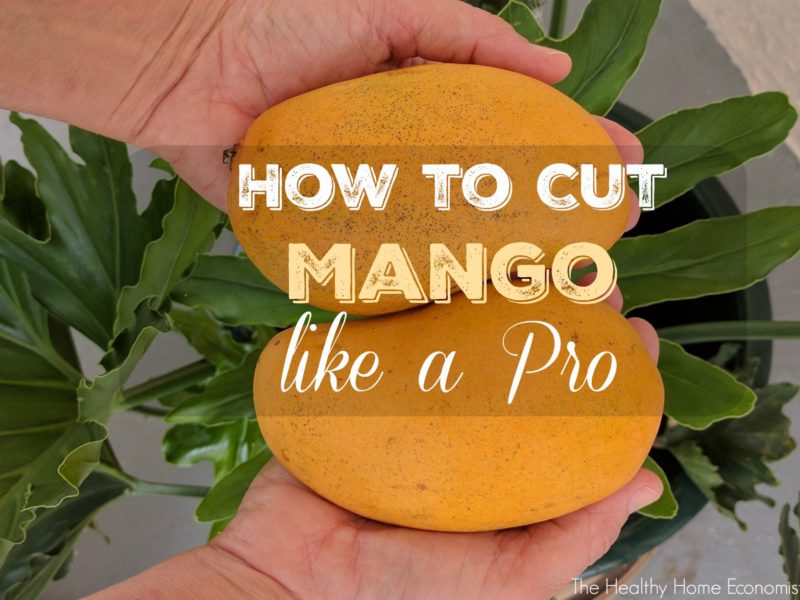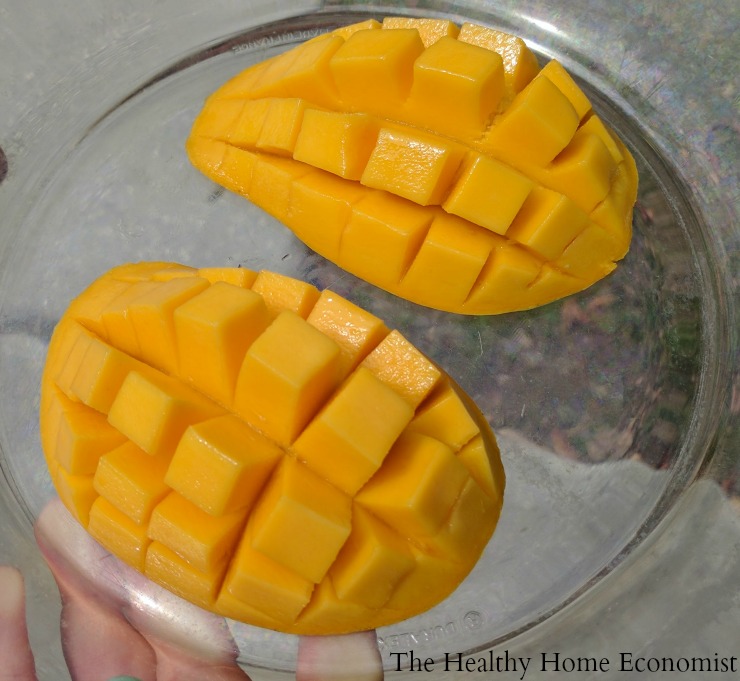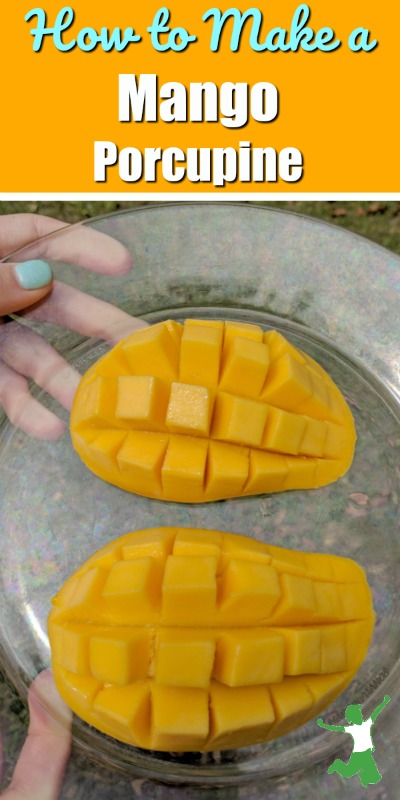
Recently, I bought a bunch of mangoes at the store because they were on sale. While checking out the cashier said, “I love mangoes, but just can’t figure out how to eat them. I tried peeling them once and made a terrible mess!”
Before showing you how to cut one up quickly and like a pro (instructions plus video demo), let’s talk about the various varieties and how they differ.
Mango Season
There are numerous varieties of mango available in North America. The worst time of year to try and find them is November through December. Otherwise, the following countries supply them during the other 10 months. While mangoes are delicious no matter when in the season you enjoy them, like oranges, they peak in flavor toward the end.
- Mexican mangoes: Available late March through September
- Florida mangoes: Best from May through September
- Haitian mangoes: January through September
- Brazilian mangoes: September through January
Buy Local and in Season if Possible
Since I live in Florida, I try to buy locally grown mangoes as much as possible. Growing a mango tree, like homegrown pineapple, is very simple and an option as well if you live in a warm clime.
The most popular USA variety is the Tommy Atkins. It is colorful with orange to orange-red skin. It is oval in shape with each fruit averaging about a pound. While sweet and juicy, this variety can tend to be a bit more fibrous than other types, so it is very important to be sure it is ripe when you cut it.
The largest of the mangoes available from Florida is known as the Keitt. It is round and very plump with each one easily weighing in at 2 or even 3 pounds! The green skin may have a touch of red. The primarily green skin fools some folks who pass it by thinking it isn’t ripe when it actually is. The great thing about the Keitt is that the pit is smaller than other mango varieties despite its large size. It is also fiber-free, so you get more fruit for your food dollar. This is an important tip because mangoes especially if organic, are not cheap!
Other Florida varieties include the Haden, the Kent, and the Palmer. You can see pictures of each variety here.
- The Haden is typically about half the size of the Keitt, weighing in a little less than a pound. It is round rather than oval. The color is green to yellow with a blush of red. The flesh is bright orange with rich flavor.
- Kent mangoes are large like the Keitt with green skin with a touch of red. Its average size is smaller than the Keitt at a pound or so and has golden flesh that is fiber-free.
- The Palmer is a long and oval-shaped. It is typically about a pound in size. It is very sweet, tasting less like a mango and more like a nectarine or peach. It is fibrous only around the pit.
Mangoes are Not Highly Sprayed
One of the great things about mangoes is that they are one of the lowest sprayed fruits. On scale of 1-100 with 100 being the most highly sprayed (peaches), mangoes score only a 9. (1)
Thus, if the budget is tight, mangoes are a great fruit to eat regularly because you don’t have to buy organic to get good quality.
How to Know if a Mango is Ripe
The first step to fully enjoy the unique taste and texture of mango is selecting a ripe one. There is nothing worse than paying $1, $2, or even $3 for a single fruit only to find after cutting it up that the flesh is too tart, too firm, and basically inedible.
Ignore the Color!
The key to picking a ripe mango that is ready to eat immediately or within a day or so is to ignore the color and instead focus on how it feels to the touch.
Even the blush of red on some individual fruit is no indication of ripeness.
Touch is the Secret
Squeeze a mango ever so gently to assess the firmness of the flesh under the skin. A ripe mango will give slightly, but not too much. Picking a good one is a similar process to picking a ripe peach or nectarine. I’ve noticed that ripe candidates sometimes have slight wrinkles in their skin.
Smell Can Help Too
Smell the stem end. Sometimes a tantalizing mango aroma can be smelled. Again, this isn’t always the case, however! The fail-safe way to pick a good mango is by gently squeezing it to find a soft one that isn’t mushy.
Don’t Eat Mango Skin
While some people can eat and enjoy mango skin without a problem, it is recommended to discard it because it has the potential to cause an allergic reaction. Known as “mango itch” in Hawaii, the sap of the mango tree and mango skin contain urushiol. This is the same chemical that triggers itchy skin and rash in poison ivy and poison oak.
How to Cut Mango (like a pro)
Once you have a ripe fruit, you are ready to cut it up. I remember the first time I attempted (and failed) to cut a mango. I made a total mess because I tried to split it in the center like other fruit. This doesn’t work because the pit of the mango runs almost completely through the center!
My husband is a total pro at cutting mangoes, and he was kind enough to jot down the steps for doing it perfectly every time. He also added how to slice up the two halves into what’s called a porcupine, so that the mango cubes are easily eaten with a spoon. The presentation is delightful too, so a properly cut mango can be used to adorn dishes or a banquet table of other fruits.
What type of mango varieties do you enjoy? Do you cut mango halves into porcupines too?

Mango Recipes to Try
Mango chutney is a favorite recipe in our home. The version I make is fermented and one of the most delicious condiments I’ve ever tasted. It goes especially well as a condiment with chicken or fish dishes.
If you wish to use the fresh-cut mango right away, mango lassi (yogurt smoothie Indian style) is a yummy beverage to try.
The recipe below includes a video demo of my tween cutting up a Tommy Atkins mango. It’s so easy to beautifully present a mango, even a child can do it!
Dried mango simply can’t compare, don’t you agree?

How to Cut Up a Mango
How to properly cut mango into a gorgeous porcupine that will wow your family and guests and be simple to eat.
Ingredients
- 1 ripe mango local and in season if possible
Instructions
-
Select a mango which has some bulk to it and some softness. Wash and rinse it thoroughly.
-
Stand the mango on one end so it is tall holding one broad side in your left hand (vice versa if you're a "leftie").
-
Use a sharp knife to slice slightly off center from the top of the right broad side shaving as closely as you can to the stone all the way to the bottom. The closer to the stone the knife passes the more flesh will be cupped in the skin. The half will fall to the right after the knife passes completely through the fruit.
-
Repeat for the other side of the fruit.
-
Once you have the skin separated, steady one half on the cutting board with the flat fruit side up.
-
Taking care not to puncture the skin, deeply score the flesh lengthwise in the very middle then make parallel scores every centimetre or so - one by one - until you reach the edge and repeat for the other side of the central score.
-
If you have cut through the flesh close enough to the skin (but not punctured it) you can now force the skin inside out so the cubes of mango flesh protrude and the fruit half is convex in shape.
-
Kids love this sweet and nutritious "porcupine"!
Recipe Video









I found out about the rash or mango “itch” the hard way after eating several fresh mangoes over the course of a couple days for the first time while in college. Got a horrible rash *inside* my mouth on my lips and inside my throat, similar to the poison ivy rash :/ I am horribly sensitive to poison ivy, but had no idea that mangoes contained a similar substance. I’ve had good luck with cooked mango though, although not quite the same as the fresh fruit. Thanks for warning people about the rash!
Dear Sarah, I love your web-site, your recipies, etc. You are a trul;y wonderful lady raising 3 beautiful, healthy children. Now to the cutting of mangos: Never! But never ever cut anything (mangoes or otherwise) toward you. In otrher words the way you should cut the mango is to put it down on the cutting board and then… just as you did! But do not cut it in your hand and never toward you!
Best Wishes,
Pete
Good point! Thanks for sharing 🙂
My best friend taught who is filipino me this. They always had mangoes at her house. After making the porcupine I use a spoon to scoop out the squares since you can slide a spoon easily between the skin and the fruit. My only problem is finding good ripe fruit in Kentucky! The last few mangoes I have bought were inedible or they never ripened up amd they are usually not cheap! Not worth it but they are soooo good when you do get a good one.
My favorite mango trick is using a drinking glass to peel the skin off. Since a picture is worth a thousand words, here is a video:
youtube.com/watch?v=0OsP1icacOY
The video will not load!
Try it again … I just tested it and it seems to be working fine.
Interesting… but it seems that you loose a lot of the fruit doing that way. it looks like to me it is about a 1/3 of the whole fruit… and a mangoe is quite expensive in France… nearly 3 €uros….
Yes, the pit in mangoes can be quite large! After making your porcupine on each side, you can use a knife to slice off a few more juicy pits from the pit. That part is not as neat and tidy a process though 🙂
In recent years I have always eaten the skin of my mangoes. Is there any reason for this not being a good idea?
(Having seen a colleague do it, I also eat the skin on a kiwi fruit)
Be aware that eating mango skin can cause an allergic reaction in some people. Known as “mango itch” in Hawaii, the sap of the mango tree and mango skin contain urushiol, the same chemical that causes itchy skin and rash from poison ivy and poison oak.
Good informational video and article! I always wondered how to do that. Now what do you do with the rest of the mango flesh still on the pit?
You can use a knife to cut off the yummy bits still attached to the pit.